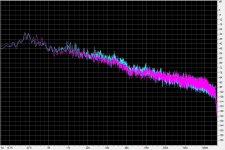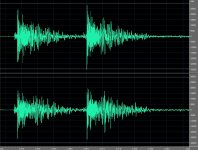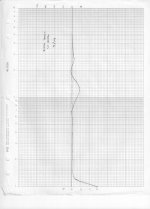If you take a device such as E.S. has proposed and it is in a seal container, not way to see the internal parts or if you placed ten different speakers behind a curtain which you could not possibly see through how is that not considered blind testing? Does the protocol for doing blind testing require that you actually need to be blindfolded or just that there is a second person who is controlling the test conditions? I'm sure that people here on many forums cheat all the time to prove their particular viewpoints and ingrained beliefs but discounting the cheats how do you actually do a wide scale test such as using Ed's boxes of unknowns without having absolute control of the test conditions? Can a public DBT even work or is this in fact just more fantasy and delusional thinking?
Testing for something like this a complicated thing. Some preliminary work is probably needed, and public testing may be usable for that. In the end, there is probably no substitute for supervised testing, but let's be sure we have worked out all the details in advance so the final test effort works as intended, and be as sure as possible that we have selected the most promising group of test subjects.
... how do you proctor the blind part.
Get grant funding from some rich audiophile to bring everyone together?
A good start would probably be to come up with a clearly defined statement of what exactly it is we are testing for.
'At the start' meaning before we start to throw ideas around about boxes and gain structure and procedures and such. 😱
Jan
'At the start' meaning before we start to throw ideas around about boxes and gain structure and procedures and such. 😱
Jan
+100!
Or another completely wasted project, as are so many.
Step 1: Define and AGREE objectives .....
Or another completely wasted project, as are so many.
Step 1: Define and AGREE objectives .....
Well then feel better and live in your world viewed through rose colored glasses.Yes a good digital source with a decent recording is better than an LP, but you could use both if you want to cover all bases and cater for those that believe LP to be a superior source🙂
Many have said it is the implementation of the circuit that is important...
How about an example of an all analog recording that is clearly superior? Chucking random insults about isn't convincing.
Jan, Different people seem to be interested in different questions. A couple of interests on my part: (1) how little distortion can an exceptionally naturally talented, and then well trained and well practiced listener detect under ideal conditions, just to set some limit on that, and (2) when someone claims to hear distortion coming out of a box that we think should be below the best possible detection limit, it would be nice if we had some way of quantifying what actual distortion is being produced by the box in question. Or, just if we want to know for some lesser reason. On this latter issue, it kind of seems like very high quality sound cards might useful for many home measurements, except there needs to be some way to calibrate the A/D and D/A. Once one is calibrated, the other can probably be deduced through secondary calibration. To do that, all we might need is a really good low distortion hardware oscillator, so we can calibrate A/D performance using that. Of course, there are limits on what could be done that way, but it would probably leave us better off than we are now.
Last edited:
Jan, Different people seem to be interested in different questions.
Of course. But unless those people agree on a clear goal, nothing will come of it.
Jan
Of course. But unless those people agree on a clear goal, nothing will come of it.
Jan
Okay, what are you interested in finding out?
+100!
Step 1: Define and AGREE objectives .....
That would kill the whole story, discussion, and forum thread.
I agree that you guys and my people will never come to an agreement about op amp differences (if any). However, to accuse our side of being biased, or (cheating) ignores your side of pre-supposing that all op amps should sound essentially the same.
I agree that you guys and my people will never come to an agreement about op amp differences (if any). However, to accuse our side of being biased, or (cheating) ignores your side of pre-supposing that all op amps should sound essentially the same.
"Pre-supposing" might not be the right word. Maybe I would describe the differences between the sides this way: (1) Both sides believe their own ears. (2) the side that hears less distortion has models and research in support of their own perceptions. (3) the side that hears more distortion has the harder task of trying find some way of measuring something that may be very hard to measure.
That would kill the whole story, discussion, and forum thread.
Which is about time....😡
Which is about time....😡
Please no, the entertainment value is priceless.
Priceless? Hey! How would you like to fund proctored testing, you know, for the entertainment value?Please no, the entertainment value is priceless.
A good start would probably be to come up with a clearly defined statement of what exactly it is we are testing for.
For clipping sound? 😛
Demian, bear
Here is the drum drop from Dafos. The CD says mastered for RR by JVC, a Professor Johnson recording. Even better it does not show up in the CD database. The whole CD seems to be mastered for about 1dB headroom from the peak of the big drum drop. The previous gamelan cut has a max level of -25dB. There is plenty of low frequency content.
Here is the drum drop from Dafos. The CD says mastered for RR by JVC, a Professor Johnson recording. Even better it does not show up in the CD database. The whole CD seems to be mastered for about 1dB headroom from the peak of the big drum drop. The previous gamelan cut has a max level of -25dB. There is plenty of low frequency content.
Attachments
Jan, Different people seem to be interested in different questions. A couple of interests on my part: (1) how little distortion can an exceptionally naturally talented, and then well trained and well practiced listener detect under ideal conditions, just to set some limit on that, and
Tested many times with many results published, but people refuse to believe it. In fact the question should really be 'why do people think 60 years of research into human hearing doesn't affect them?'.
(2) when someone claims to hear distortion coming out of a box that we think should be below the best possible detection limit, it would be nice if we had some way of quantifying what actual distortion is being produced by the box in question. Or, just if we want to know for some lesser reason. On this latter issue, it kind of seems like very high quality sound cards might useful for many home measurements, except there needs to be some way to calibrate the A/D and D/A. Once one is calibrated, the other can probably be deduced through secondary calibration. To do that, all we might need is a really good low distortion hardware oscillator, so we can calibrate A/D performance using that. Of course, there are limits on what could be done that way, but it would probably leave us better off than we are now.
There are several people on this forum with an AP or access to one, so accurate measurements are possible. But as the average sound card when used by someone well versed in measurement can already measure below any limit set in 1) not sure its worth the cost.
As an aside, I have noticed that many people go gooey over the Neve consoles build for Air studios. I am happy to say I know zip about studio consoles but do know these are full of 5534s and that I have failed to find an album recorded on them that I would say could be used as an example of superior sound. There are rumours Dire Straits used it for Brothers in Arms, which isn't tooo shabby.
Then again people get even gooier about the Neve 8078. Go figure
Of course, there is adequate low frequency response. Even if you started with a standard 30ips tape recorder, as it is possible to add a corresponding bass boost (easily adjusted with a rec-repro sweep), with little problem because the low frequency info is recorded on the 30 ips tape, and only the reproduce tape head needs to be compensated for. Actually, in practice, usually a 12dB/oct boost would be added after the -3dB response of a typical Studer deck, for example, as low as you might want to go. This is not where a 30ips tape will fail to make it because of a useful frequency response.
Attachments
Last edited:
Tested many times with many results published, but people refuse to believe it.
If you could help me out by pointing to the most definitive study you are referring to, it would be most appreciated. I have seen some reference to improvements resulting from training, but I didn't see anything about exactly what the training consisted of, or the exact specifications for the playback equipment used. Without knowing more about those things, I can't tell you if it seems credible or not. If you can tell me where to find it, I will even pay for the privilege of reading it.
Regarding sound cards, I can hear the distortion in my Lynx2, which many might argue should not be audible. That's why I have the HEDD for recording and the DAC-1 for playback. They sound better to me, and as I said before, you can even hear the differences in both of the the A/D converters on the CD I mentioned recently.
Lastly, a lot of the Neve sound is in the transformers. I have some Sowter output transformers for a Neve 1272 and use them for making a clean mic preamp a little dirty, or for mastering when more of a magnetic tape sound is desired. One of them by itself isn't quite enough for my tastes most of the time, but two in series is too much. About one and half would probably suit my preferences best. I also use a pot to load them, as they are usually fed into a bridging input and loading impedance affects the sound.
Last edited:
- Status
- Not open for further replies.
- Home
- General Interest
- Everything Else
- What is wrong with op-amps?


